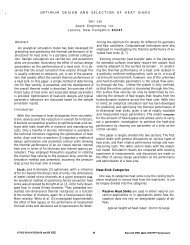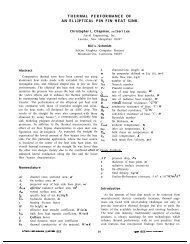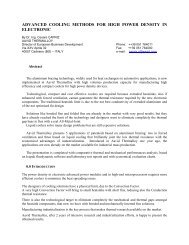the thermal resistance of pin fin heat sinks in transverse flow
the thermal resistance of pin fin heat sinks in transverse flow
the thermal resistance of pin fin heat sinks in transverse flow
- No tags were found...
Create successful ePaper yourself
Turn your PDF publications into a flip-book with our unique Google optimized e-Paper software.
grid CFD simulations will provide a more accurate prediction <strong>of</strong> fullyducted <strong>heat</strong> s<strong>in</strong>k behavior than most practical CFD models <strong>of</strong> <strong>the</strong> complete<strong>heat</strong> s<strong>in</strong>k.Nu , f Ratio10.90.80.70.60.5Figure 4. Grid-sensitivity <strong>of</strong> friction factor and NusseltnumberA CFD model <strong>of</strong> <strong>the</strong> s<strong>in</strong>gle row <strong>of</strong> <strong>p<strong>in</strong></strong>s with <strong>the</strong> grid density <strong>of</strong> 225from Figure 4 was used to develop <strong>the</strong> build<strong>in</strong>g block correlations for<strong>the</strong> analytical model. While not entirely grid <strong>in</strong>dependent, <strong>the</strong> forthcom<strong>in</strong>gdiscussion will show that <strong>the</strong> CFD models strike a reasonable balancebetween provid<strong>in</strong>g good agreement with empirical data andeconomy <strong>of</strong> computational effort.Results obta<strong>in</strong>ed from <strong>the</strong> CFD simulations <strong>in</strong>clude <strong>the</strong> per-row frictionfactor, Nusselt number, and <strong>the</strong> <strong>the</strong>rmal wake function. Figures 5aand 5b respectively show <strong>the</strong> per <strong>p<strong>in</strong></strong> friction factor results for squareand non-square arrays us<strong>in</strong>g <strong>the</strong> same format as Zukauskas[12]. Forsquare arrays <strong>the</strong> per <strong>p<strong>in</strong></strong> friction factor for each value <strong>of</strong> X Lis computedas de<strong>f<strong>in</strong></strong>ed <strong>in</strong> <strong>the</strong> nomenclature. The friction factor ratio χ fornon-square arrays is computed by divid<strong>in</strong>g <strong>the</strong> friction factor result for<strong>the</strong> X T≠ X Lsimulation by <strong>the</strong> result for <strong>the</strong> square array with <strong>the</strong> sameX L. As shown <strong>in</strong> Figure 5(a), <strong>the</strong> CFD results for square arrays are <strong>in</strong>good agreement with <strong>the</strong> empirical data compiled by Zukauskas over <strong>the</strong>range X L= X T= 1.5…2.5 . Results shown <strong>in</strong> Fig. 5(b) for <strong>the</strong> nonsquarearrays agree quite well with <strong>the</strong> empirical data for X T< X Lbutare low for X T> X L. For calculat<strong>in</strong>g <strong>the</strong> friction factor we use equation(4) and <strong>the</strong> coefficients given <strong>in</strong> Table 3. This correlation is based onempirical data from Zukauskas [12] except for <strong>the</strong> last row <strong>in</strong> <strong>the</strong> tablewhich is based on <strong>p<strong>in</strong></strong> <strong>f<strong>in</strong></strong> <strong>heat</strong>s<strong>in</strong>k data from Jonsson and Moshfegh[13].where X =Nuf0 100 200 300 400 500Grid Density1/mf = X – 0.754 ⋅ (( C1Re – 0.8 ) m + C2 m ) 10 < Re < 3000( X T– 1)-------------------( X L– 1)f/χ10TABLE 3. Coefficients for <strong>the</strong> friction factorcorrelationX L C1 C2 m1.5 48 0.30 2.52.0 23 0.25 2.02.5 12 0.18 1.74.3 9 0.10 1.11Zukauskas (XL=1.5)Zukauskas (XL=2.0)Zukauskas (XL=2.5)0.110 100 1000 10000(a)Reχ(b)10.01.00.10.1 1 10(X T-1)/(X L-1)Re=2000Re=200Re=20Figure 5. Friction factor results from s<strong>in</strong>gle-row CFDmodelFigure 6 compares <strong>the</strong> Nusselt numbers at <strong>the</strong> fourth <strong>p<strong>in</strong></strong> <strong>in</strong> <strong>the</strong> <strong>flow</strong>direction with empirical correlations over <strong>the</strong> Reynolds number rangefrom 10 to 3000 and <strong>the</strong> comb<strong>in</strong>ations <strong>of</strong> X L and X T listed <strong>in</strong> Table 2.The predictions agree very well with <strong>the</strong> empirical correlations <strong>of</strong>Zukauskas over <strong>the</strong> whole range studied except for <strong>the</strong> <strong>in</strong>termediaterange 100 < Re < 1000 where <strong>the</strong> correlation equation appears to below probably due to a typographical error <strong>in</strong> [12]. The CFD results arewell represented by slightly modify<strong>in</strong>g and blend<strong>in</strong>g <strong>the</strong> correlationsprovided by Zukauskas for Reynolds number ranges above and belowthis <strong>in</strong>termediate range us<strong>in</strong>g <strong>the</strong> follow<strong>in</strong>g equation also shown <strong>in</strong> Figure6.Nu = (( 0.85Re 0.4 Pr 0.36 ) 10 + ( 0.26Re 0.63 Pr 0.36 ) 10 ) 110 /(4)4
This correlation is used for all <strong>the</strong> <strong>p<strong>in</strong></strong>s <strong>in</strong> <strong>the</strong> array based on a <strong>p<strong>in</strong></strong> by<strong>p<strong>in</strong></strong> Nusselt number study at Re ~ 750 which showed that <strong>the</strong> fourth <strong>p<strong>in</strong></strong>data was representative <strong>of</strong> all <strong>the</strong> <strong>p<strong>in</strong></strong>s <strong>in</strong> <strong>the</strong> array with<strong>in</strong> +−2 percentexcept for <strong>the</strong> first <strong>p<strong>in</strong></strong> which was only 5 percent higher. The reasonableagreement seen between CFD and empirical results for <strong>the</strong> friction factorand Nusselt number provides support for <strong>the</strong> <strong>the</strong>rmal wake functiondeterm<strong>in</strong>ed from <strong>the</strong> same CFD simulations.Nu10010XT=2 XL=2XT=2 XL=2.5XT=2.5 XL=2XT=1.5 XL=2XT=2.5 XL=2.5XT=1.5 XL=1.5XT=2 XL=1.5ZukauskasEquation (5)have higher values <strong>of</strong> . This means that with <strong>in</strong>creas<strong>in</strong>g <strong>transverse</strong>pitch <strong>the</strong> bulk temperature decreases much faster (as 1/S T ) than <strong>the</strong> adiabatictemperature rise <strong>in</strong> <strong>the</strong> wake <strong>of</strong> <strong>the</strong> <strong>heat</strong>ed <strong>p<strong>in</strong></strong>. This is just whatwould be expected when fluid convection dom<strong>in</strong>ates. Because our CFDresults are not entirely grid <strong>in</strong>dependent <strong>the</strong> reader should note that <strong>the</strong>true magnitude <strong>of</strong> is somewhat greater than <strong>the</strong> values reported here.θ13.53.02.52.0θ 1θ 1XT=2.5 XL=2XT=2, XL=2XT=1.5 XL=2Equation (6)1.5110 100 1000 10000ReFigure 6. Nusselt number results from s<strong>in</strong>gle-row CFDsimulationsThe wake function is modeled <strong>in</strong> two parts, <strong>the</strong> first accounts for <strong>the</strong>adiabatic temperature rise <strong>of</strong> <strong>the</strong> first <strong>p<strong>in</strong></strong> downstream <strong>of</strong> <strong>the</strong> <strong>heat</strong>ed <strong>p<strong>in</strong></strong>and <strong>the</strong> second part accounts for <strong>the</strong> decay <strong>of</strong> <strong>the</strong> wake function downstreamfrom <strong>the</strong> first <strong>p<strong>in</strong></strong>. In order to arrive at a suitable correlation welooked for asymptotes for <strong>the</strong> wake function at low and high Reynoldsnumbers and <strong>the</strong>n blended <strong>the</strong> two toge<strong>the</strong>r us<strong>in</strong>g <strong>the</strong> method <strong>of</strong>Churchill and Usagi [15]. Follow<strong>in</strong>g Zukauskas, we first addressedsquare arrays where X T= X Land <strong>the</strong>n looked at deviations for configurationswhere X T≠ X L. The result<strong>in</strong>g correlations are <strong>in</strong>spired by <strong>the</strong>underly<strong>in</strong>g physics <strong>of</strong> <strong>the</strong> data ra<strong>the</strong>r than a multi-parameter fit to a largeset <strong>of</strong> data. The wake function for <strong>the</strong> first <strong>p<strong>in</strong></strong> is well represented by <strong>the</strong>follow<strong>in</strong>g equation which is compared <strong>in</strong> Figure 8 with CFD results forthree configurations which represent <strong>the</strong> upper and lower bound values<strong>of</strong> θ 1<strong>in</strong> our CFD study.θ 11 ϕ 1 1 0.015Reϕ 1 0.71.00 500 1000 1500 2000 2500 3000ReFigure 7. Wake function at first <strong>p<strong>in</strong></strong> downstream <strong>of</strong> <strong>heat</strong>ed<strong>p<strong>in</strong></strong>The decay <strong>of</strong> <strong>the</strong> <strong>the</strong>rmal wake at <strong>the</strong> downstream <strong>p<strong>in</strong></strong>s is well representedby <strong>the</strong> follow<strong>in</strong>g correlation function for square and non-squarearrays.( θ i– 1)( ------------------ =θ 1– 1)e ni–1– ( ) + ( 1 – X)The value <strong>of</strong> <strong>the</strong> exponent n may be determ<strong>in</strong>ed for a given longitud<strong>in</strong>alpitch by <strong>in</strong>terpolation from <strong>the</strong> values tabulated <strong>in</strong> Table 4.TABLE 4. Coefficients for Wake DecayX L n1.5 1.702.0 1.052.5 0.904.3 0.85(7)where=+[ + ( / ) 2 ] – 0.7/2{ –}ϕ = ( X L– 1) ( 1.2X 2 – 0.64X + 0.48)As shown <strong>in</strong> Figure 7, <strong>the</strong> correlation equation provides a good fitfor <strong>the</strong> data over <strong>the</strong> whole range studied. The figure shows that <strong>the</strong>value <strong>of</strong> θ 1starts at 1.0 (i.e. adiabatic temperature rise is equal to <strong>the</strong>bulk temperature rise) at low Re where <strong>heat</strong> diffusion is dom<strong>in</strong>ant,<strong>in</strong>creases sharply up to an Re ~ 200 as convection becomes more andmore dom<strong>in</strong>ant and <strong>the</strong>n more slowly at Re > 500 towards a high Reasymptote <strong>of</strong> 1 + ϕ . A comparison between <strong>the</strong> data for <strong>the</strong> three differentgeometries shows that configurations with a larger <strong>transverse</strong> pitch(5)(6)Heat S<strong>in</strong>k Model FrameworkWe consider a <strong>heat</strong> s<strong>in</strong>k composed <strong>of</strong> an array <strong>of</strong> circular <strong>p<strong>in</strong></strong> <strong>f<strong>in</strong></strong>s asshown <strong>in</strong> Figure 2. The length L <strong>of</strong> each <strong>p<strong>in</strong></strong> is constant <strong>in</strong> <strong>the</strong> z direction.The air<strong>flow</strong> is assumed to approach <strong>the</strong> <strong>p<strong>in</strong></strong> <strong>f<strong>in</strong></strong> array <strong>in</strong> <strong>the</strong> x-directionwith a uniform velocity and temperature and to rema<strong>in</strong> twodimensionalwith<strong>in</strong> <strong>the</strong> array (no velocity <strong>in</strong> <strong>the</strong> z-direction). Thermalwake effects are limited to <strong>f<strong>in</strong></strong>s situated along <strong>the</strong> same <strong>flow</strong> stream, i.e.with<strong>in</strong> <strong>the</strong> same y and z segments.5
.U aT <strong>in</strong>SegmentNumberOdzT fkP<strong>in</strong> Number 1 2 ... i ... N21T 0q kFigure 8. Heat transfer from an <strong>in</strong>terior <strong>f<strong>in</strong></strong> <strong>in</strong> <strong>the</strong> arrayWe exam<strong>in</strong>e <strong>heat</strong> transfer from a <strong>f<strong>in</strong></strong> with<strong>in</strong> <strong>the</strong> array with <strong>the</strong> aid <strong>of</strong>Figure 8. The <strong>f<strong>in</strong></strong> is divided <strong>in</strong>to several segments along its length start<strong>in</strong>gfrom <strong>the</strong> base. Heat transfer from each segment <strong>of</strong> <strong>the</strong> <strong>f<strong>in</strong></strong> is drivenby <strong>the</strong> same overall temperature potential; <strong>the</strong> difference between <strong>the</strong>base temperature <strong>of</strong> <strong>the</strong> <strong>f<strong>in</strong></strong> and <strong>the</strong> <strong>in</strong>let temperature <strong>of</strong> <strong>the</strong> air. Thispotential can be separated <strong>in</strong>to three dist<strong>in</strong>ct parts compris<strong>in</strong>g <strong>the</strong> conductionwith<strong>in</strong> <strong>the</strong> <strong>f<strong>in</strong></strong>, convection from <strong>the</strong> <strong>f<strong>in</strong></strong> surface and upstream<strong>heat</strong>up <strong>of</strong> <strong>the</strong> air as follows:These separate pieces can be written <strong>in</strong> terms <strong>of</strong> <strong>the</strong> <strong>heat</strong> transferredfrom each segment <strong>of</strong> <strong>the</strong> <strong>f<strong>in</strong></strong>. For segment k on <strong>the</strong> i th <strong>f<strong>in</strong></strong> <strong>in</strong> <strong>the</strong> <strong>flow</strong>direction, <strong>the</strong>se terms become:z kT adT 0– T <strong>in</strong>= ( T 0– T f) + ( T f– T ad) +( T ad– T <strong>in</strong>)(8)path. The path is constra<strong>in</strong>ed only <strong>in</strong> <strong>the</strong> sense that it represent a <strong>flow</strong>streamtube which must be known apriori.Equations (10) through (12) can be substituted <strong>in</strong> equation (9) toyield <strong>the</strong> <strong>heat</strong> balance equation for each segment <strong>of</strong> each <strong>f<strong>in</strong></strong>∑1 ≤ l≤kz l⎛-----------⎝λ mA f⎠, 1+ ------------ + --------------------------- q (12)hPdz ρU ac pS Tdz ∑ l, kθ i–l– T 0= T <strong>in</strong>One more equation is needed to specify <strong>the</strong> <strong>heat</strong> <strong>in</strong>put or temperatureboundary condition at <strong>the</strong> base <strong>of</strong> each <strong>f<strong>in</strong></strong> as follows:(13)where is a switch with a value <strong>of</strong> ei<strong>the</strong>r 1 for a specified <strong>heat</strong> <strong>in</strong>putboundary condition or 0 for a specified base temperature boundary conditionfor <strong>the</strong> i th <strong>p<strong>in</strong></strong>.The above equations (13) and (14) comprise a set <strong>of</strong> N ⋅ ( O + 1)equations for a similar number <strong>of</strong> unknowns (q for O segments on each<strong>of</strong> N <strong>f<strong>in</strong></strong>s plus T 0 for N <strong>f<strong>in</strong></strong>s). This set <strong>of</strong> equations can be written <strong>in</strong>matrix form and solved us<strong>in</strong>g standard matrix <strong>in</strong>version methods todeterm<strong>in</strong>e <strong>the</strong> <strong>heat</strong> <strong>flow</strong> and temperature distribution with<strong>in</strong> <strong>the</strong> row <strong>of</strong><strong>f<strong>in</strong></strong>s. These equations were implemented <strong>in</strong> a commercial ma<strong>the</strong>maticscode MathCad [16]. Correlation equations described earlier for <strong>the</strong> frictionfactor, Nusselt number and <strong>the</strong>rmal wake for circular <strong>p<strong>in</strong></strong> <strong>f<strong>in</strong></strong>s wereimplemented <strong>in</strong> <strong>the</strong> model. The solution results for q and T 0 can be usedwith equations (10) and (11) to determ<strong>in</strong>e <strong>the</strong> <strong>f<strong>in</strong></strong> temperature and adiabatictemperature for each segment <strong>of</strong> each <strong>f<strong>in</strong></strong>.S iq⎞ qi , lS iq∑lq i,lq ik1 ≤ l < iq q q+ ( 1–S i)T 0= S i Qi + ( 1–S i)Tb iT 0–T f=∑1 ≤ l ≤kz l⎛-----------⎝λ mA f⎠⎞ qi , l(9)Heat Transfer from F<strong>in</strong> Segments to AirF<strong>in</strong> temperatures <strong>in</strong> ArrayT f–T ad=q i k------------ ,hPdz(10)1T ad– T <strong>in</strong>= --------------------------- qρU ac pS Tdz ∑ lk1 ≤ l < i,θ i–l(11)whereq i,kθ i – lz kis <strong>the</strong> <strong>heat</strong> transfer from segment k on <strong>p<strong>in</strong></strong> iis <strong>the</strong> wake function on <strong>p<strong>in</strong></strong> i due to <strong>heat</strong> transferred from <strong>p<strong>in</strong></strong> lis <strong>the</strong> distance from <strong>the</strong> base to <strong>the</strong> center <strong>of</strong> segment k <strong>of</strong> <strong>the</strong> <strong>f<strong>in</strong></strong>dz kis <strong>the</strong> length <strong>of</strong> segment k <strong>of</strong> <strong>the</strong> <strong>f<strong>in</strong></strong>AπDfis <strong>the</strong> cross-sectional area <strong>of</strong> <strong>the</strong> <strong>f<strong>in</strong></strong> ⎛=---------2 ⎞⎝ 4 ⎠Note that value <strong>of</strong> T ad can be set equal to <strong>the</strong> bulk temperature by specify<strong>in</strong>gθ i–l= 1 . The adiabatic temperature rise expressed <strong>in</strong> equation(12) conta<strong>in</strong>s <strong>in</strong>formation on <strong>the</strong> path <strong>of</strong> <strong>the</strong> fluid <strong>flow</strong> through <strong>the</strong> <strong>p<strong>in</strong></strong><strong>f<strong>in</strong></strong> array and <strong>the</strong> order <strong>in</strong> which <strong>the</strong> various <strong>p<strong>in</strong></strong>s are arranged along thatqFigure 9. Sample solution from a one-row <strong>p<strong>in</strong></strong> <strong>f<strong>in</strong></strong> arraymodel (D=1 mm, S T =S L =3 mm, L=25 mm, U a =4m/s, T a =0 C, Tb=100 C)Figure 9 presents a typical result from <strong>the</strong> model for a row with ten<strong>p<strong>in</strong></strong>s each with five segments. This model computes <strong>the</strong> solution <strong>in</strong> under2 seconds on a personal computer with an Intel P3 CPU runn<strong>in</strong>g at 650MHz. As seen <strong>in</strong> Figure 9, this model provides a detailed account<strong>in</strong>g <strong>of</strong><strong>the</strong> <strong>heat</strong> transfer rates and temperature distribution for each <strong>f<strong>in</strong></strong> <strong>in</strong> <strong>the</strong>row. A check <strong>of</strong> <strong>the</strong> temperature distribution on <strong>the</strong> first <strong>p<strong>in</strong></strong> showedexcellent agreement with 1-D models for conduction <strong>in</strong> a <strong>f<strong>in</strong></strong> with a uniformconvective <strong>heat</strong> transfer coefficient from <strong>the</strong> <strong>f<strong>in</strong></strong> surface to fluid ata uniform temperature. On downstream <strong>f<strong>in</strong></strong>s, <strong>the</strong> fluid temperatureT6
ecomes non-uniform so temperature predictions depart from <strong>the</strong> 1-D<strong>f<strong>in</strong></strong> model.Mov<strong>in</strong>g a step fur<strong>the</strong>r we developed <strong>the</strong> model to represent a <strong>heat</strong>s<strong>in</strong>k hav<strong>in</strong>g a conduct<strong>in</strong>g base and a two dimensional array <strong>of</strong> <strong>f<strong>in</strong></strong>s. Heattransfer from each row <strong>of</strong> <strong>f<strong>in</strong></strong>s is treated as before but each <strong>f<strong>in</strong></strong> is nowconnected to a <strong>heat</strong> s<strong>in</strong>k base <strong>of</strong> <strong>f<strong>in</strong></strong>ite thickness. Heat conduction with<strong>in</strong><strong>the</strong> base is solved us<strong>in</strong>g a standard <strong>f<strong>in</strong></strong>ite volume approach [17] withboundary conditions supplied on <strong>the</strong> lower surface <strong>of</strong> <strong>the</strong> <strong>heat</strong> s<strong>in</strong>k base.A simple version <strong>of</strong> base conduction was implemented by sett<strong>in</strong>g <strong>the</strong>size <strong>of</strong> each <strong>f<strong>in</strong></strong>ite volume equal to <strong>the</strong> volume <strong>of</strong> <strong>the</strong> base under each<strong>f<strong>in</strong></strong>, i.e., S T× S L× tb . The base temperature T 0 for a <strong>f<strong>in</strong></strong> is now <strong>the</strong> basetemperature at <strong>the</strong> center <strong>of</strong> <strong>the</strong> <strong>f<strong>in</strong></strong>ite volume below that <strong>f<strong>in</strong></strong>. Thermalconductance terms connect <strong>the</strong> temperature <strong>in</strong> a control volume to adjacentcontrol volumes <strong>in</strong> <strong>the</strong> x and y directions and to <strong>the</strong> boundary conditionsspecified on <strong>the</strong> lower surface <strong>of</strong> <strong>the</strong> <strong>heat</strong> s<strong>in</strong>k base. The <strong>heat</strong>conduction equation for <strong>the</strong> base control volume below <strong>the</strong> i th <strong>p<strong>in</strong></strong> <strong>in</strong> <strong>the</strong>j th row can be written as follows:( q2C x+ 2C y+ S i, jCz)T + i j 0–λwhere <strong>the</strong> conductance terms are mS Ttb λ= -----------------, C mS Ltby= ----------------- , andC zAn additional <strong>resistance</strong> R ⎛ c =⎝, ,q ijk , ,k(14)is added to <strong>the</strong> term⎛-----------⎞<strong>in</strong> equation (13) to account for conduction between <strong>the</strong> position⎝λ mA f⎠at which T 0 is now computed and <strong>the</strong> base <strong>of</strong> <strong>the</strong> actual <strong>f<strong>in</strong></strong>. This term<strong>in</strong>cludes <strong>the</strong> constriction <strong>resistance</strong> at <strong>the</strong> base <strong>of</strong> <strong>the</strong> <strong>f<strong>in</strong></strong>. The <strong>heat</strong> transferfrom <strong>the</strong> top surface <strong>of</strong> <strong>the</strong> <strong>heat</strong> s<strong>in</strong>k base around <strong>the</strong> <strong>f<strong>in</strong></strong>s is <strong>in</strong>cluded<strong>in</strong> <strong>the</strong> convective <strong>heat</strong> transfer expression for <strong>the</strong> first segment <strong>of</strong> <strong>the</strong> <strong>f<strong>in</strong></strong>.The <strong>heat</strong> transfer coefficient on <strong>the</strong> base area was assumed to be 0.5times <strong>the</strong> <strong>heat</strong> transfer coefficient on <strong>the</strong> surface <strong>of</strong> <strong>the</strong> <strong>f<strong>in</strong></strong>s based on datareported by Metzger et. al [18]. The constant <strong>of</strong> proportionality willma<strong>in</strong>ly affect <strong>the</strong> <strong>the</strong>rmal <strong>resistance</strong> predictions for <strong>heat</strong> <strong>s<strong>in</strong>ks</strong> withsparse <strong>p<strong>in</strong></strong> <strong>f<strong>in</strong></strong> arrays where <strong>heat</strong> transfer from <strong>the</strong> wall area is significant.This wall <strong>heat</strong> transfer coefficient is very difficult to measure experimentallyand its dependence on <strong>the</strong> array geometry, aspect ratio (L/D) <strong>of</strong><strong>the</strong> <strong>p<strong>in</strong></strong>s, Reynolds number etc. is not known sufficiently and is a candidatefor fur<strong>the</strong>r study, maybe us<strong>in</strong>g CFD. The <strong>heat</strong> transfer from <strong>the</strong> <strong>f<strong>in</strong></strong>tips has been left out <strong>of</strong> <strong>the</strong> present model but it can be easily <strong>in</strong>cluded <strong>in</strong><strong>the</strong> expression for <strong>the</strong> last segment <strong>of</strong> <strong>the</strong> <strong>f<strong>in</strong></strong> if <strong>the</strong> <strong>f<strong>in</strong></strong> tips are exposed toair <strong>flow</strong>.Extensions <strong>of</strong> <strong>the</strong> Heat S<strong>in</strong>k modelAlthough we have focused on a simple <strong>transverse</strong> <strong>flow</strong> aligned with<strong>in</strong>-l<strong>in</strong>e rows <strong>of</strong> <strong>p<strong>in</strong></strong> <strong>f<strong>in</strong></strong>s to develop <strong>the</strong> model, <strong>the</strong> approach presented∑C xT – i – 1, j,0C xT – C T C i + 1, j,0 y i , j – 1 , 0– T y ij , 1 ,=qS i, jQij2λ mS LS= --------------------- T.tbz l,+ ( 1 – S ij)C zTb i,j,qC xS Ltb---------------------- + --------------1 ⎞2λ mS TS K2λ mD⎠+ 0S There is readily extendable to non-orthogonal <strong>transverse</strong> <strong>flow</strong>s <strong>in</strong>clud<strong>in</strong>gim<strong>p<strong>in</strong></strong>g<strong>in</strong>g <strong>flow</strong>s. This would be done by partition<strong>in</strong>g <strong>the</strong> <strong>flow</strong> field <strong>in</strong>tostreamtubes (see [7]) which del<strong>in</strong>eate <strong>the</strong> correspond<strong>in</strong>g <strong>the</strong>rmal wakel<strong>in</strong>kages between segments, represent<strong>in</strong>g new effective <strong>p<strong>in</strong></strong> rows, whichmay even be curved. Equation (12) provides <strong>the</strong> means to implementany “<strong>flow</strong> stream connectivity” implied by <strong>the</strong> <strong>flow</strong> streamtubes thatdescribe <strong>the</strong> <strong>flow</strong> path through <strong>the</strong> array. If <strong>the</strong> wake function correlationsare not available, a suitable first step is to set <strong>the</strong> wake function tounity.O<strong>the</strong>r types <strong>of</strong> <strong>f<strong>in</strong></strong>s such as <strong>in</strong>terrupted plate, elliptical, w<strong>in</strong>g shapedetc. can be modeled us<strong>in</strong>g <strong>the</strong> same <strong>heat</strong> s<strong>in</strong>k model by simply provid<strong>in</strong>g<strong>the</strong> applicable correlation equations for Nusselt number and friction factor,e.g. those described by Muzychka and Yovanovich [19] for <strong>of</strong>fsetstrip <strong>f<strong>in</strong></strong> arrays.MODEL RESULTS AND DISCUSSIONThe <strong>heat</strong> s<strong>in</strong>k model was compared aga<strong>in</strong>st <strong>the</strong> experimental data <strong>of</strong>Jonsson and Moshfegh [13] for a <strong>heat</strong> s<strong>in</strong>k consist<strong>in</strong>g <strong>of</strong> a 9 x 9 array <strong>of</strong>10 mm long 1.5 mm diameter <strong>p<strong>in</strong></strong> <strong>f<strong>in</strong></strong>s arranged on a square grid with apitch <strong>of</strong> 6.5 mm. We assumed a base thickness <strong>of</strong> 4 mm s<strong>in</strong>ce this wasnot provided <strong>in</strong> [13]. Pressure drop and <strong>the</strong>rmal <strong>resistance</strong> predictionswere made for a fully ducted configuration for approach velocities rang<strong>in</strong>gfrom 1.7 to 9 m/s correspond<strong>in</strong>g to a Reynolds number range fromabout 200 to 1100.CFD simulations were conducted us<strong>in</strong>g Icepak [14] for <strong>the</strong> above<strong>heat</strong> s<strong>in</strong>k geometry us<strong>in</strong>g three levels <strong>of</strong> grid re<strong>f<strong>in</strong></strong>ement. Even at <strong>the</strong> <strong>f<strong>in</strong></strong>estgrid which used ~450,000 control volumes <strong>the</strong> CFD results were notgrid <strong>in</strong>dependent. Fur<strong>the</strong>r grid re<strong>f<strong>in</strong></strong>ement was not conducted because<strong>the</strong> computational array sizes exceeded <strong>the</strong> physical memory on <strong>the</strong>desktop PC (~512 MB). Each CFD simulation took 44 m<strong>in</strong>utes to complete.Thermal Resistance(C/W)32.521.51R-Data [13]R-ModelR-CFD 449,320 gridsDP-Data [13]DP-ModelDP-CFD 449,320 grids0.500.00 3.00 6.00 9.00Approach Velocity Ua (m/s)Figure 10. Model predictions for a <strong>p<strong>in</strong></strong> <strong>f<strong>in</strong></strong> <strong>heat</strong> s<strong>in</strong>kcompared to experimental data <strong>of</strong> [13]200160120Figure 10 shows that <strong>the</strong> predictions from <strong>the</strong> model are <strong>in</strong> excellentagreement with <strong>the</strong> experimental data while <strong>the</strong> CFD simulations showconsiderable differences. For <strong>the</strong> model, <strong>the</strong> excellent agreement with<strong>the</strong> pressure drop data is to be expected s<strong>in</strong>ce <strong>the</strong> data itself was used todeterm<strong>in</strong>e <strong>the</strong> coefficients for <strong>the</strong> friction factor model (shown <strong>in</strong> Table3). However, <strong>the</strong> good agreement over <strong>the</strong> whole velocity range shows<strong>the</strong> good correlation that is achieved between <strong>the</strong> Reynolds number and<strong>the</strong> friction factor through equation (4).The excellent agreement between <strong>the</strong> model predictions and experimentaldata for <strong>the</strong>rmal <strong>resistance</strong> validates <strong>the</strong> Nusselt number correla-8040Pressure Drop (Pa)7
tion used and provides confidence <strong>in</strong> <strong>the</strong> overall model <strong>in</strong>clud<strong>in</strong>g <strong>the</strong>choice <strong>of</strong> <strong>the</strong> proportionality constant for <strong>the</strong> <strong>heat</strong> transfer coefficient on<strong>the</strong> base surface around <strong>the</strong> <strong>f<strong>in</strong></strong>s. If <strong>the</strong> proportionality constant were setto 1.0 <strong>in</strong>stead <strong>of</strong> 0.5, <strong>the</strong> predicted <strong>the</strong>rmal <strong>resistance</strong> would decrease by6.5% at 1.7 m/s and by 10% at 9 m/s. The <strong>in</strong>fluence <strong>of</strong> <strong>the</strong> <strong>the</strong>rmal wakefunction <strong>in</strong> this case is more significant. If <strong>the</strong> adiabatic temperature risewere replaced by <strong>the</strong> bulk temperature rise (by sett<strong>in</strong>g θ i – l= 1 ) <strong>in</strong> <strong>the</strong>calculation <strong>of</strong> <strong>heat</strong> transfer from <strong>the</strong> <strong>f<strong>in</strong></strong>s, <strong>the</strong> predicted <strong>the</strong>rmal <strong>resistance</strong>would be reduced by 18% at 1.7 m/s and by 12% at 9 m/s airvelocity.CONCLUSIONSA physics based model for <strong>p<strong>in</strong></strong> <strong>f<strong>in</strong></strong> <strong>heat</strong> <strong>s<strong>in</strong>ks</strong> <strong>in</strong> forced convectionhas been developed. Key empirical data and correlations for <strong>the</strong> pressuredrop and <strong>heat</strong> transfer <strong>in</strong> <strong>in</strong>-l<strong>in</strong>e arrays <strong>of</strong> circular <strong>p<strong>in</strong></strong> <strong>f<strong>in</strong></strong> arrays werevalidated through CFD simulations. New correlation equations weredeveloped to represent <strong>the</strong> empirical friction factor data. New knowledgeabout <strong>the</strong> <strong>the</strong>rmal wake with<strong>in</strong> <strong>the</strong> <strong>p<strong>in</strong></strong> <strong>f<strong>in</strong></strong> arrays was developedfrom <strong>the</strong> CFD simulations. Correlations to represent <strong>the</strong> <strong>the</strong>rmal wakewere developed. An attempt was made to accurately represent with<strong>in</strong> <strong>the</strong>model framework <strong>the</strong> most relevant mechanisms govern<strong>in</strong>g <strong>heat</strong> transportwith<strong>in</strong> <strong>the</strong> <strong>heat</strong>s<strong>in</strong>k structure <strong>in</strong>clud<strong>in</strong>g <strong>heat</strong> transfer from <strong>the</strong> <strong>f<strong>in</strong></strong>sand <strong>the</strong> fluid wetted wall <strong>of</strong> <strong>the</strong> base, <strong>heat</strong> spread<strong>in</strong>g <strong>in</strong> <strong>the</strong> base and <strong>the</strong>rmalwake effects due to fluid rout<strong>in</strong>g through <strong>the</strong> <strong>f<strong>in</strong></strong> array. The modelwas implemented us<strong>in</strong>g <strong>the</strong> commercial ma<strong>the</strong>matics s<strong>of</strong>tware Mathcad.Predictions from <strong>the</strong> model were <strong>in</strong> good agreement with experimentaldata, much better than grid-limited CFD results for <strong>the</strong> full <strong>heat</strong> s<strong>in</strong>k.The model provides a framework for putt<strong>in</strong>g exist<strong>in</strong>g literature correlationsand <strong>in</strong>formation developed from detailed <strong>f<strong>in</strong></strong>e-grid CFD simulationsto work <strong>in</strong> <strong>the</strong> design <strong>of</strong> <strong>p<strong>in</strong></strong> <strong>f<strong>in</strong></strong> <strong>heat</strong> <strong>s<strong>in</strong>ks</strong>. At a m<strong>in</strong>imum, <strong>the</strong>model can be expected to predict <strong>heat</strong> s<strong>in</strong>k performance similar to adetailed CFD model with a fraction <strong>of</strong> <strong>the</strong> data entry and computationaleffort. Better yet, <strong>the</strong> <strong>in</strong>corporation <strong>of</strong> empirical <strong>in</strong>formation allows <strong>the</strong>present model to capture complex physical effects which would requirehuge detailed CFD models to simulate from scratch each time. Last butnot least, <strong>the</strong> model provides detailed but easily <strong>in</strong>terpreted resultsregard<strong>in</strong>g <strong>heat</strong> transport and temperatures with<strong>in</strong> <strong>the</strong> <strong>heat</strong> s<strong>in</strong>k structure.It is anticipated that <strong>the</strong> model will become a valuable tool to enableconsistent performance comparisons and selection between varioustypes <strong>of</strong> <strong>p<strong>in</strong></strong> <strong>f<strong>in</strong></strong> and plate <strong>f<strong>in</strong></strong> <strong>heat</strong> <strong>s<strong>in</strong>ks</strong>.REFERENCES[1] Bejan, A., and Sciubba,E., 1992, “The optimal spac<strong>in</strong>g <strong>of</strong> parallelplates cooled by forced convection,” Int. J. Heat Mass Transfer,Vol. 35, pp. 3259-3264[2] Bejan, A. and Morega, A. M., 1993, “Optimal arrays <strong>of</strong> <strong>p<strong>in</strong></strong> <strong>f<strong>in</strong></strong>s andplate <strong>f<strong>in</strong></strong>s <strong>in</strong> lam<strong>in</strong>ar forced convection,” ASME Journal <strong>of</strong> HeatTransfer, Vol. 115, pp. 75-81.[3] Culham, J.R. and Muzychka, Y. S., 2001, “Optimization <strong>of</strong> plate <strong>f<strong>in</strong></strong><strong>heat</strong> <strong>s<strong>in</strong>ks</strong> us<strong>in</strong>g entropy generation m<strong>in</strong>imization,” IEEE Trans.Comp. Packag. Technol., Vol 24, pp. 159-165.[4] Iwasaki, H., Sasaki, T., and Ishizuka, M., 1994, “Cool<strong>in</strong>g performance<strong>of</strong> plate <strong>f<strong>in</strong></strong>s for multichip modules,” <strong>in</strong> Proc. Fourth Intersoc.Conf. Thermal Phenomena <strong>in</strong> Electronic Systems, ITHERM1994, pp. 144-147.[5] Teertstra P.M., Yovanovich, M. M., Culham, J. R. and Lemczyk, T.F., 1999, “Analytical forced convection model<strong>in</strong>g <strong>of</strong> plate <strong>f<strong>in</strong></strong> <strong>heat</strong><strong>s<strong>in</strong>ks</strong>,” <strong>in</strong> Proc. 15th Annu. IEEE Semicon. Thermal Meas. Manag.Symp., San Diego, CA, March 9-11, pp. 34-41.[6] S. Lee, “Optimum design and selection <strong>of</strong> <strong>heat</strong> <strong>s<strong>in</strong>ks</strong>”, <strong>in</strong> Proc. 11thIEEE SEMI-THERM Symposium, 1995, pp. 48-54.[7] Holahan, M. F., Kang, S. S., and Bar-Cohen, A. 1996, “A <strong>flow</strong>streambased analytical model for design <strong>of</strong> parallel plate <strong>heat</strong><strong>s<strong>in</strong>ks</strong>”,<strong>in</strong> Proc. 31st National Heat Transfer Conference, ASMEHTD-Vol. 329-7, pp 63-71.[8] Chen,C.L., Peppi, K., Day, S., Liao, C., 1998, “Thermal analysisdesign tool for parallel plate <strong>heat</strong><strong>s<strong>in</strong>ks</strong>”, <strong>in</strong> Proc. Sixth Intersoc.Conf. on Thermal Phenomena, ITHERM 1998, pp371-377.[9] H. Shaukatullah, W. R. Storr, B. J. Hansen, M.A. Gaynes, 1996,“Design and optimization <strong>of</strong> <strong>p<strong>in</strong></strong> <strong>f<strong>in</strong></strong> <strong>heat</strong> <strong>s<strong>in</strong>ks</strong> for low velocityapplications”, 12th IEEE SEMI-THERM Symposium, pp.151-163.[10] Jonsson H. and Palm, B. 1996, “Experimental comparison <strong>of</strong> differen<strong>the</strong>at s<strong>in</strong>k designs for cool<strong>in</strong>g <strong>of</strong> electronics,” <strong>in</strong> Proc. 31stNational Heat Transfer Conference, ASME HTD-Vol. 329-7, pp27-34.[11] Dogruoz M. B., Urdaneta, M., Ortega, A. and Westphal, R. V.,2002, “Experiments and model<strong>in</strong>g <strong>of</strong> <strong>the</strong> hydraulic <strong>resistance</strong> <strong>of</strong> <strong>in</strong>l<strong>in</strong>esquare <strong>p<strong>in</strong></strong> <strong>f<strong>in</strong></strong> <strong>heat</strong> <strong>s<strong>in</strong>ks</strong> with top bypass <strong>flow</strong>,” <strong>in</strong> Proc. EighthIntersociety Conference on Thermal Phenomena, ITHERM 2002,pp. 251-260.[12] Zukauskas, A., 1987, “Convective <strong>heat</strong> transfer <strong>in</strong> cross <strong>flow</strong>,” <strong>in</strong>:Handbook <strong>of</strong> S<strong>in</strong>gle-Phase Convective Heat Transfer, S. Kakac,R.K. Shah and W. Aung, eds., Wiley, New York, Chap. 6.[13] H. Jonsson, B. Moshfegh, 2001, “Model<strong>in</strong>g <strong>of</strong> <strong>the</strong> <strong>the</strong>rmal andhydraulic performance <strong>of</strong> plate <strong>f<strong>in</strong></strong>, strip <strong>f<strong>in</strong></strong>, and <strong>p<strong>in</strong></strong> <strong>f<strong>in</strong></strong> <strong>heat</strong> <strong>s<strong>in</strong>ks</strong> -Influence <strong>of</strong> <strong>flow</strong> bypass”, IEEE Trans. Components and Packag<strong>in</strong>gTechnologies, Vol. 24, No. 2, pp. 142-149.[14] Icepak 4.0, 2002, Fluent Inc., Lebanon NH.[15] Churchill, S. W. and Usagi, R.,1972, “A general expression for <strong>the</strong>correlation <strong>of</strong> rates <strong>of</strong> transfer and o<strong>the</strong>r phenomena,” J. AmericanInstitute <strong>of</strong> Chemical Eng<strong>in</strong>eers, Vol 18, pp. 1121-1128.[16] Mathcad 2001i, 2001, MathS<strong>of</strong>t Eng<strong>in</strong>eer<strong>in</strong>g and Education, Inc.,Cambridge, MA.[17] Patankar, S.V., 1980, Numerical Heat Transfer and Fluid Flow,Hemisphere, Wash<strong>in</strong>gton, DC.[18] Metzger, D. E., Fan, C. S., and Haley, S. W., 1984, “Effects <strong>of</strong> P<strong>in</strong>Shape and Array Orientation on Heat Transfer and Pressure Loss <strong>in</strong>P<strong>in</strong> F<strong>in</strong> Arrays,” Journal <strong>of</strong> Eng<strong>in</strong>eer<strong>in</strong>g for Gas Turb<strong>in</strong>es andPower, Vol. 106, pp. 252-257.[19] Muzychka, Y. S. and Yovanovich, M. M., 1999, “Model<strong>in</strong>g <strong>the</strong> fand j Characteristics <strong>of</strong> <strong>the</strong> Offset Strip F<strong>in</strong> Array,” ASME HTD-Vol. 364-1, pp 91-100.8














